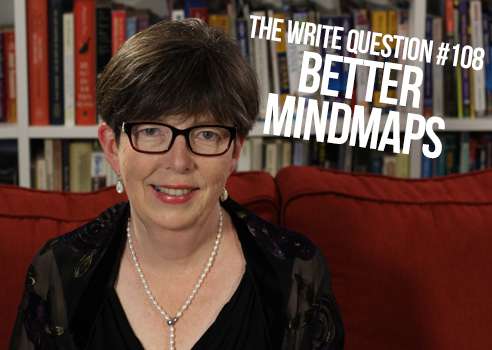Viewing time: 5 mins.. 16 secs.
The Write Question is a weekly video podcast about writing that I started in 2017 and that ran, more or less weekly, until April 2022. This is a republication of issue #108, which gives advice on how to create a better mindmap. The post first ran on Sept. 20/19.
Transcript:
Are you having difficulty mindmapping? That’s the topic I’ll be addressing today in The Write Question. I’m Daphne Gray-Grant, the Publication Coach.
Here’s a question from Hermano Veronese, a writer based in Brazil. His native language is Portuguese so he didn’t feel comfortable recording the question in English but here’s what he wrote in an email:
“All of my mind maps look like a preview of the main topics I want to discuss in my writing. I guess my brain isn’t used to this more creative approach. How do you suggest I overcome this “block”? Then, suppose I manage to mindmap in the right way — what do I do next? My mindmap looks like a cloud of chaotic ideas and facts. I’m finding it hard to turn it into a coherent narrative, in a good logical sequence. Any clues on that?”
Thanks for the question, Hermano. As you know, I emailed you back and asked you to provide me with a sample mindmap. I don’t speak Portuguese, but just glancing at it gave me a few hints as to what might be going on for you.
First, I don’t think you’ve asked a question in the centre of the page. In fact, I can’t actually read your writing but there’s no question mark there, and it’s only two words – not quite long enough for a proper question.
Here’s why questions are so important: They provoke your brain and they inspire you to be more precise. If you present yourself with a topic, say, “Facebook,” you may not become interested enough. But if you ask yourself a question, say — WHY is Facebook so annoying? — then you’re more likely to feel curious and fully engaged.
Also, questions force you to declare a point for your piece of writing. And points are something that readers truly want. Your goal should not be simply to share information with people — that’s way too vague and boring! Instead, you want to convince readers of something.
Again, without speaking Portuguese, I can only guess what the other little bubbles in your mindmap said. But I imagine they are general categories of the sort you might find in an outline. Mindmaps should be more creative than that.
Let me share a mindmap that I produced for a blog post I wrote about the fear of writing. (Link below) Here’s the handwritten version first. And here’s a version I’ve transposed into Mindmapping software, so you don’t have to read my horrible handwriting.
The little bubble on the far left-hand side, saying “Lion’s story” became the organizing metaphor for the entire post. You’d never know just by looking at the mindmap, but as soon as I remembered the Lion’s story, I knew exactly how I would begin the post.
Telling that story took me 461 of 760-words. In other words, more than half. And ostensibly, that story has nothing to do with writing.
But it’s interesting and it makes an emotional connection that makes the entire post more compelling. Also, I spell out the writing lessons from the anecdote at the end.
Mindmaps are not outlines turned sideways. They are graphic documents meant to explore stories and metaphors and emotional connections. When you have the right question in the centre of the page, you’ll know when you’re ready to write because you’ll feel excited and lifted up.
Also be aware that one mindmap does not necessarily equal one story. If you suddenly feel inspired to write when you’re only halfway through the mindmap, then stop mindmapping and start writing.
On the other hand, if you don’t feel like writing after the first mindmap, then use that mindmap to develop a different question for a second mindmap. And if that one doesn’t inspire you either, then do a third one. And if that one doesn’t work, do a fourth. Do a fifth, sixth or seventh if necessary.
A mindmap should take you only three to five minutes, so your maximum time investment, even with seven mindmaps, will be only 35 minutes. I’ve known writers who will stare at a blank screen that long!
You won’t be wasting time with mindmapping. Instead, you’ll be making yourself much more familiar with your topic. And besides that, the process is fun!
Finally, let me wrap up with a quote from the late American writer Maya Agnelou: “You can’t use up creativity. The more you use, the more you have.”
Hermano, a mindmap is not an organizational tool. It’s an inspirational one. Don’t expect it to tell you the order in which you should write material. Instead, expect it to get you excited about the idea of writing. I’ve done lots of posts and videos on mindmapping. See the link below, to get complete access to them.


